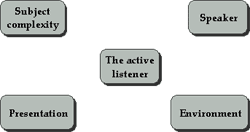Active Listening
Active listening is a way of listening and responding to another person that improves mutual understanding. Often when people talk to each other, they don't listen attentively. They are often distracted, half listening, half thinking about something else. When people are engaged in a conflict, they are often busy formulating a response to what is being said. They assume that they have heard what their opponent is saying many times before, so rather than paying attention, they focus on how they can respond to win the argument. Active listening is a structured form of listening and responding that focuses the attention on the speaker. The listener must take care to attend to the speaker fully, and then repeats, in the listener's own words, what he or she thinks the speaker has said. The listener does not have to agree with the speaker--he or she must simply state what they think the speaker said. This enables the speaker to find out whether the listener really understood. If the listener did not, the speaker can explain some more.[1]
Degrees of Active Listening[2]
There is no universally accepted definition of active listening because its main elements were already in widespread use before clinical psychologist Carl Rogers popularized the term in 1957. Rogers described active listening from a therapeutic standpoint and his original definitions are not all that helpful in everyday workplace communications
A listener can use several degrees of active listening, each resulting in a different quality of communication.
The active listening chart below shows the three main degrees of listening: • Repeating • Paraphrasing • Reflecting

source: Free Online Library for Managers
The Four Rules of Active Listening
- Seek to understand before you seek to be understood: When we seek to understand rather than be understood, our modus operandi will be to listen. Often, when we enter into conversation, our goal is to be better understood. We can be better understood, if first we better understand. With age, maturity, and experience comes silence. It is most often a wise person who says little or nothing at the beginning of a conversation or listening experience. We need to remember to collect information before we disseminate it. We need to know it before we say it.
- Be non judgmental: Empathetic listening demonstrates a high degree of emotional intelligence. There is a reason kids do not usually speak with adults about drugs, sex, and rock and roll. The kids already know what the adults have to say. Once a child knows your judgment, there is little reason to ask the question unless the intention is to argue. If we would speak to anyone about issues important to them, we need to avoid sharing our judgment until we have learned their judgment.
- Give your undivided attention to the speaker: Absolutely important is dedicating your undivided attention to the speaker if you are to succeed as an active listener. Eye contact is less important. In most listening situations people use eye contact to affirm listening. The speaker maintains eye contact to be sure the listener or listeners are paying attention. From their body language the speaker can tell if he is speaking too softly or loudly, too quickly or slowly, or if the vocabulary or the language is inappropriate. Listeners can also send messages to speakers using body language. Applause is the reason many performers perform. Positive feedback is an endorphin releaser for the giver and the sender.
- Use silence effectively: The final rule for active or empathic listening is to effectively use silence. Too often a truly revealing moment is never brought to fruition because of an untimely interruption. Some of the finest police interrogators, counselors, teachers and parents learn more by maintaining silence than by asking questions. As an active or empathic listener, silence is a very valuable tool. DO NOT interrupt unless absolutely necessary. Silence can be painful. It is more painful for a speaker than for a listener. If someone is speaking, and we want them to continue talking, we do not interrupt. Rather, we do provide positive feedback using body language, eye contact, and non word sounds like "umh, huh". Silence is indeed golden especially when used to gather information as a listener.
References
- ↑ What is Active Listening? University of Colorado
- ↑ Degrees of Active Listening Free Management Books
